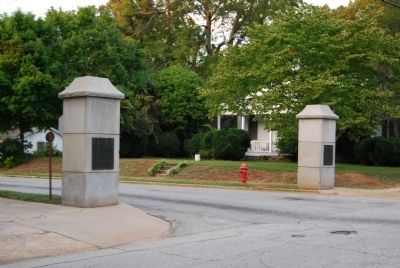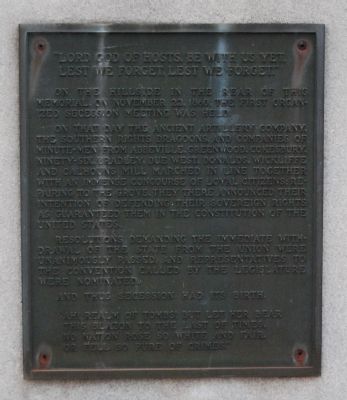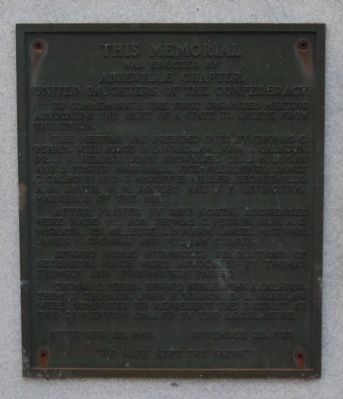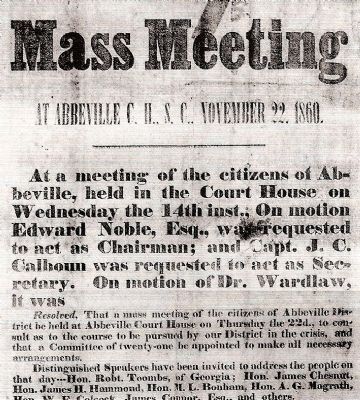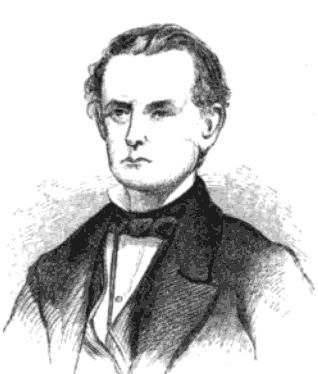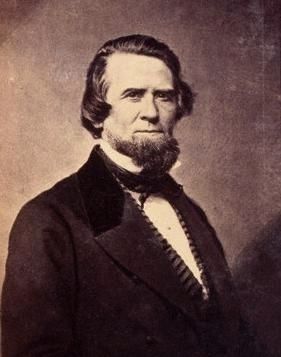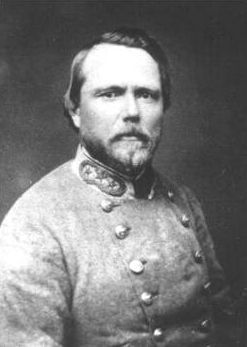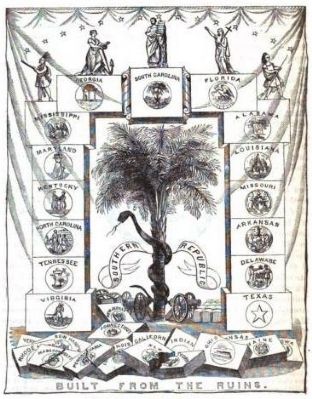Abbeville in Abbeville County, South Carolina — The American South (South Atlantic)
First Secession Meeting Columns
Inscription.
Northwest
Lest We Forget, Lest We Forget
On the hillside in the rear of this memorial on November 22, 1860, the first organized secession meeting was held.
On that day the ancient artillery company, the Southern Rights Dragoons, and companies of minute-men from Abbeville, Greenwood, Cokesbury, Ninety-Six, Bradley, Due West, Donalds, Wickliffe, and Calhoun's Mill marched in line together with an immense concourse of loyal citizens; repairing to the grove. They there announced their intention of defending their sovereign rights as guaranteed them in the Constitution of the United States.
Resolutions demanding the immediate withdrawal of the state from the Union were unanimously passed and representatives to the convention called by the legislature were nominated.
"Ah realm of tombs! But let her bear
This blazon to the last of times,
No Nation rose so white and fair,
Or fell so pure of crimes."
Northeast
Was Erected by
Abbeville Chapter
United Daughters of the Confederacy
This meeting was presided over by Thomas C. Perrin, with Judge D.L. Wardlaw, John A. Calhoun, Dr. J.W. Hearst, John Brownlee, Dr. J.H. Logan and J. Foster Marshall, vice presidents; James C. Calhoun and G. McDuffie Miller, secretaries; A.M. Smith, W.M. Rogers and J.F. Livingston, Marshals of the Day.
After prayer by Rev. North, addresses were made by Hon. Thomas C. Perrin, Hon. A.C. McGrath, Gen. Milledge L. Bonham, Samuel McGowan, James N. Cochran and William C. Davis.
Edward Noble introduced resolutions of secession, which were advocated by Thomas Thomson and unanimously passed.
Thomas C. Perrin, Edward Noble, John A. Calhoun, Thomas Thomson, John H. Wilson, D.L. Wardlaw were nominated to represent the district at the convention called by the legislature.
"We have left the faith."
Erected 1927 by Abbeville Chapter, United Daughters of the Confederacy.
Topics and series. This historical marker is listed in these topic lists: Government & Politics • War, US Civil. In addition, it is included in the United Daughters of the Confederacy series list. A significant historical date for this entry is November 22, 1860.
Location. 34° 10.617′ N, 82° 22.417′ W. Marker is in Abbeville, South Carolina, in Abbeville County. Marker is at the intersection of Magazine Street and Secession Avenue (County Road 120) on Magazine Street. Touch for map. Marker is in this post office area: Abbeville SC 29620, United States of America. Touch for directions.
Other nearby markers. At least 10 other markers are within walking distance of this marker. Henry McNeal Turner (about 400 feet away, measured in a direct line); Secession Hill (about 600 feet away); Conservation Cabin (about 700 feet away); This Water Fountain (about 700 feet away); Marie Cromer Seigler (about 700 feet away); a different marker also named Secession Hill (about 700 feet away); First Secession Meeting Boulder (about 800 feet away); Abbeville County Veterans Memorial (approx. ¼ mile away); Operation Desert Shield / Storm Monument (approx. ¼ mile away); Belmont Inn (1903) (approx. ¼ mile away). Touch for a list and map of all markers in Abbeville.
More about this marker. The four verses on the northwest column are part of a poem written by Philip Stanley Worsley. The full poem appears in Worsley's 1865 English translation of Homer's Iliad which he dedicated to General Robert E. Lee.
Also see . . .
1. Milledge Luke Bonham. Milledge Luke Bonham (December 25, 1813 – August 27, 1890) was an American politician and Congressman who served as the Governor of South Carolina from 1862 until 1864. (Submitted on November 20, 2009, by Brian Scott of Anderson, South Carolina.)
2. Samuel McGowan. Samuel McGowan (October 19, 1819 – August 9, 1897) was a general from South Carolina in the Confederate States Army during the American Civil War. (Submitted on November 20, 2009, by Brian Scott of Anderson, South Carolina.)
3. Declaration of the Immediate Causes Which Induce and Justify the Secession of South Carolina. Full text of South Carolina's declaration of secession. (Submitted on November 20, 2009, by Brian Scott of Anderson, South Carolina.)
Additional commentary.
1. The Great Secession Meeting
The Great Secession Meeting
November 22, 1860
Abbeville Medium
Robert R. Hemphill
May 2, 1907
I remember the great Secession meeting in Abbeville in 1860 which was an introduction to the War Between the States. It was on the twenty-second day of November and a great multitude was in the town. Augustus M. Smith was Marshal of the day. W.M. Rogers and J.F. Livingston were his assistants. The procession formed in the public square and escorted by about 500-Minutemen marched in the grove near the Southern depot where the mass meeting was organized by electing T.C. Perrin, President; Judge D.L. Wardlaw, Col. John A. Calhoun, Dr. J.W. Hearst, Capt. John Brownlee, and Dr. John A.
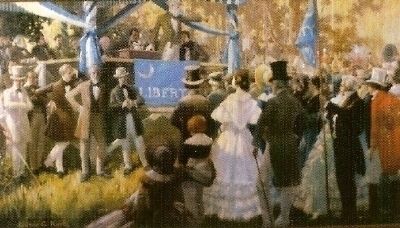
Photographed By Wilbur George Kurtz
4. The First Organized Mass Meeting for Secession
One of South Carolina's earliest organized mass meetings for secession was held in Abbeville on November 22, 1860. In this painting, Judge A.G. McGrath of Charleston, the principal speaker is seen making his argument in favor of secession. The other speakers that day were General M.L. Bonham, Congressman McGowan, Major Armistead Burt, and others of equal prominence.
Hon. A.G. Magrath of Charleston was the first speaker and I remember his first sentence was, “The time for speaking has passed and the time for action has arrived.” He rolled his “r’s” in fine style. He was a very handsome man and made a capital speech urging immediate action on the part of South Carolina at any and every hazard. He was followed by Hon. M.L. Bonham who also favored immediate action. Resolutions were unanimously adopted favoring secession of the state.
A Committee of Twenty was appointed to select nominees for the Convention which met December 17, 1860. While this Committee was out, speeches were made by Samuel McGowan, W.C. Davis, and J.N. Cochran. The following gentlemen were elected to the Convention: Edward Noble, John A. Calhoun, Thomas Thomson, John H. Wilson, and D.L. Wardlaw. Called upon for an expression of views, each one endorsed the resolutions adopted which were published in the county newspapers. The speeches, however, were not recorded and lost to the generations that came after.
It was not, however, the official action of the mass meeting that I now undertake to record. It is the small and commonplace incidents of the day. I came down with several students from Due West which was rather a conservative community,
a place where the war spirit had not reached. Four of us did not join the procession but stood on the sidewalk where the post office now is. Near us was a great watch hung out as a sign that H.T. Tusten was in business there. W.W. Lindsay and I.L. Grier of Due West, Robert Yeldell of Alabama and I kept together during the way. Yeldell would not march in the procession because he was afraid of giving offense to Samuel Jordan, a kinsman who held strong Union sentiments. We could not get near enough to hear much of the speeches and so we sat down on the ground and watched the firing of a cannon at intervals during the meeting. It was all new to us and we wondered how anyone could stand before artillery. In time, however, we learned the lesson. The last I saw of Yeldell, he was a lieutenant in an Alabama artillery company with the army near Yorktown in 1862. I.L. Grier was killed at the battle of Gaines’ Mill. W.W. Lindsay was mortally wounded at Snicker’s Gap in Virginia, November 2, 1862, and died on the 20th day of the same month, and only I escaped to tell the story.
There was a man in the crowd that day from Turkey Creek on the Saluda side of the District. His name was Wesley A. Robertson. He was up in years, well past the military age, slender in figure, with keen eyes, and full of good humor. When Judge Wardlaw in his speech inquired what we would do if a revenue cutter
of the U.S. Navy would come into Charleston harbor to collect duties on imports, W.W. Perryman made some interruption and Robertson shouted, “I’d wade in and sink her, ---- her, sink her.” He never heard the last of it while the war was on. He was not the kind of man to help get up a fight and not back out of it. He and his boys went to the front. He did all his age and strength would allow as a member of Co. G, Orr’s Rifles, the famous command. In the winter of 1863-1864 when camped near Orange, he was sent up the mountains upon light duty to look after commissary supplies. Returning from his detail when he came in sight of the regiment, he wore a high crowned, white stove pipe hat and was mounted on a skewbald or calico horse. He was greeted with the cry, “sink her, ---- her, sink her,” and received with the warmest welcome. No joke of his comrades ever disturbed his equanimity and the pleasure of his comrades in seeing him on this occasion was particularly enhanced by the fact that he had in his commissary wagon a barrel or two of eggs for Co. G, which he had received from the pretty mountain girls for telling their fortunes. He always told them something good and pleasant. After the close of hostilities, he went west and died in Texas in 1894.
I write this narrative to keep in the minds of our people a son of Abbeville past the vigor of young
manhood and gray-haired, who fought a good fight and risked all for his home and friends.
— Submitted November 20, 2009, by Brian Scott of Anderson, South Carolina.
2. First Secession Meeting Columns
This marker tells the story of the first organized meeting of secession. In 1907, Abbevillian Robert R. Hemphill, a veteran of the Marshall Riflemen, Company G, First (Orr's) S.C. Rifle Regiment, wrote this about the 1860 event: "The procession formed in the public square and escorted by about 500-Minutemen marched to the grove near the Southern depot where the mass meeting was organized. The Honorable A.G. Magrath was the first speaker and I remember his first sentence was 'The time for speaking has passed and the time for action has arrived.'" Magrath and Bonham favored immediate action, and resolutions were unanimously adopted favoring secession of the state. The original secession meeting was described as "one of the largest and most enthusiastic meetings ever held in our district."
Sixty-seven years later, The Abbeville (Secession) Chapter, D.D.C., worked diligently to raise funds for these nine-foot granite pillars. The dedication ceremony took place on Secession Hill, also known as Magazine Hill, on Tuesday, December 20, 1927. A mammoth parade marched from Confederate
Park to Secession Hill. Among the throng of Abbevillians who attended the ceremony were four participants of the Secession Meeting of 1860. J.L. Perrin was the master of ceremonies. Perrin was the grandson of Thomas C. Perrin, who presided over the first meeting in 1860. Anderson lawyer Milledge L. Bonham, son of the former governor and Confederate general, delivered an eloquent and forceful address to the large assembly, recalling the events leading up to the Secession Meeting and reminding the Abbevillians of the heroism of their ancestors in the long struggle. Mrs. Fred Cason, past president of the V.D.C., presented the memorial columns to the city of Abbeville. As Thomas Thomson's great-grandson lowered the Stars and Bars and Margaret Cox read "The Conquered Banner," five great-grandsons of those who attended the First Meeting withdrew the red and white coverings, "revealing the beautiful and symmetrical shafts to the eyes of the hundreds assembled." The impressive ceremony brought tears to the eyes of many. (Source: A Guide to Confederate Monuments in South Carolina: "Passing the Silent Cup" by Robert S. Seigler (1997), pg 33-34.)
— Submitted November 20, 2009, by Brian Scott of Anderson, South Carolina.
3. Milledge Luke Bonham (1813-1890)
Milledge Luke Bonham, a Representative from South Carolina; born near Red Bank (now Saluda), Edgefield District, S.C., December 25, 1813; attended private schools in Edgefield District and at Abbeville, S.C.; was graduated from South Carolina College (now the University of South Carolina) at Columbia in 1834; studied law; was admitted to the bar and commenced practice in Edgefield in 1837; served as major and adjutant general of the South Carolina Brigade in the Seminole War in Florida in 1836; during the Mexican War was lieutenant colonel and colonel of the Twelfth Regiment, United States Infantry; major general of the South Carolina Militia; member of the State house of representatives 1840-1843; solicitor of the southern circuit of South Carolina 1848-1857; elected as a Democrat to the Thirty-fifth and Thirty-sixth Congresses and served from March 4, 1857, until his retirement on December 21, 1860; appointed major general and commander of the Army of South Carolina by Gov. F. W. Pickens in February 1861; appointed brigadier general in the Confederate Army April 19, 1861; resigned his commission January 27, 1862, to enter the Confederate Congress; elected Governor of South Carolina in December 1862 and served until December 1864; appointed brigadier general of Cavalry in the Confederate Army in February 1865; again a member of the State house of representatives 1865-1866; delegate to the Democratic National Convention in 1868; member of the South Carolina taxpayers’ convention in 1871 and 1874; resumed the practice of law in Edgefield, engaged in planting, and also conducted an insurance business in Edgefield, S.C., and Atlanta, Ga., 1865-1878; appointed State railroad commissioner in 1878 and served until his death at White Sulphur Springs, N.C., August 27, 1890; interment in Elmwood Cemetery, Columbia, S.C. (Source: Biographical Directory of the U.S. Congress.)
— Submitted November 20, 2009, by Brian Scott of Anderson, South Carolina.
4. Edward Noble
Edward Noble was the fourth child and third son of S.C. Governor Patrick Noble and Elizabeth Bonneau Pickens, daughter of Ezekiel and Elizabeth Bonneau Pickens. Governor Patrick Noble was a son of Major Alexander Noble, husband of Catherine Calhoun, a daughter of Ezekiel Calhoun, and sister of Rebecca Floride Calhoun, wife of General Andrew Pickens.
Edward Noble married Mary Bratton and they had two daughters: Mary Noble and Floride Noble.
(Source: http://freepages.books.rootsweb.ancestry.com/~pickensarchive/day/day05b.html.)
— Submitted November 20, 2009, by Brian Scott of Anderson, South Carolina.
5. Thomas Thompson
Thomas Thomson was born in Scotland on the 5th of June, 1813, and went to Abbeville, South Carolina, in his youth. After he grew up he taught school for a time and studied law under the Honorable Armistead Burt. For many years he was associated with Colonel Robert A. Fair in the practice of his profession, the name of the firm being Thomson & Fair. At the bar, he stood deservedly high, his tastes causing him to prefer civil practice. There was no lack of substantial recognition of his ability, and he amassed sufficient to make him independent of the chances of the future. In Abbeville district, he had his home until the end. There he made his reputation, and there, in consequence, he was best known.
In 1846, Judge Thomson was elected a member of the State Legislature, distinguishing himself there by the cogency and brevity of his utterances. With the exception of two terms, he served continuously as Representative and afterward as Senator until 1868. When the State seceded, exchanging the gown for the sword, he went into service as captain of a company from Abbeville in the Second Regiment of Rifles, rising step by step to the rank of colonel. His bravery was everywhere conspicuous, and he enjoyed the full confidence of his men. Upon his election as State Senator in 1862, Colonel Thomson resigned his commission in the army.
He was a member of the cooperation convention in 1851 and as a member of the secession convention in 1860 signed the ordinance of secession. From the time of the dissolution of the State Government, prior to the Reconstruction of 1868, he remained in private life until February 1878, when he was elected by the General Assembly Judge of the Eighth Judicial Circuit, receiving one hundred and thirty-seven of the one hundred and thirty-nine votes cast. The next month he was elected a Judge of the Court of Claims before which the issues involving the validity of a portion of the State debt were tried. Judge Thomson delivered the leading opinion of the court, sustaining generally the report of the bond commission.
Judge Thomson was at one time, under the old judicial system, a prominent candidate for chancellor, and came very near an election. When the General Assembly was called on to elect circuit judges in 1878, Judge Thomson was looked upon as the man of all men to place upon the bench. In the discharge of his duties, he was patient, courteous, conscientious, and painstaking.
Judge Thomson was an elder of the Presbyterian Church, enjoying the fullest confidence of his associates. The office of treasurer of the De La Howe fund he held for many years and managed to protect it and keep it intact during the Radical era in South Carolina.
Judge Thomson was married first to Miss Eliza Allen. Three children of this marriage reached maturity. Second, to Mrs. M.M. Hollingsworth, whose maiden name was Gomillion. Of this marriage, four children survived.
The death of Judge Thomson, which occurred at his home in Abbeville on May 6, 1881, was wholly unexpected; there was no illness or loss of mental vigor to prepare the public for the loss of one whose career was marked by eminent talent in his profession, by gallant service during the Confederate War, and in every relation of life by steady, modest worth. Not offensive or impulsive, he was amiable to those whom he liked and a firm friend of those whom he trusted. (Source: South Carolina Bench and Bar by Ulysses Robert Brooks (1908), pg 258-259.)
— Submitted November 20, 2009, by Brian Scott of Anderson, South Carolina.
Credits. This page was last revised on January 3, 2018. It was originally submitted on September 22, 2008, by Brian Scott of Anderson, South Carolina. This page has been viewed 3,889 times since then and 42 times this year. Photos: 1, 2, 3. submitted on September 22, 2008, by Brian Scott of Anderson, South Carolina. 4. submitted on November 15, 2009, by Brian Scott of Anderson, South Carolina. 5. submitted on November 16, 2008, by Brian Scott of Anderson, South Carolina. 6, 7. submitted on November 19, 2009, by Brian Scott of Anderson, South Carolina. 8. submitted on May 3, 2009, by Brian Scott of Anderson, South Carolina. 9. submitted on November 19, 2009, by Brian Scott of Anderson, South Carolina.
